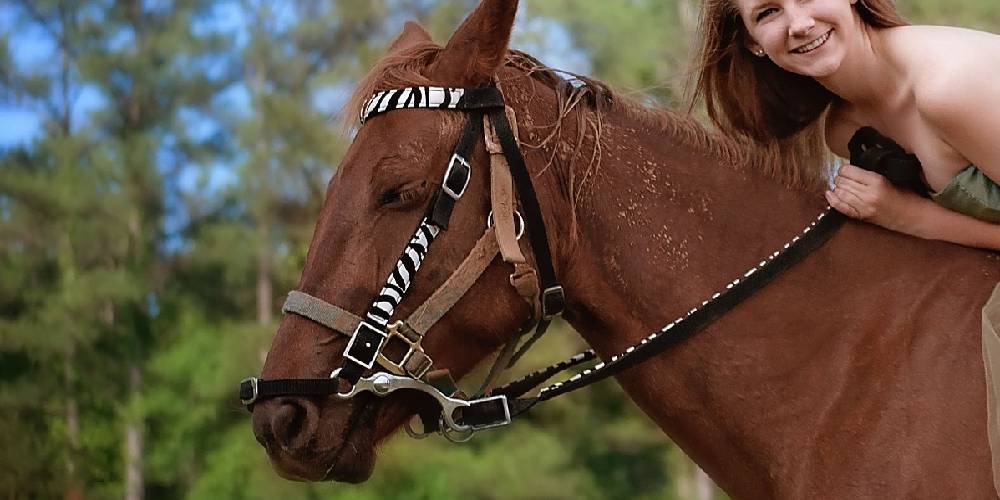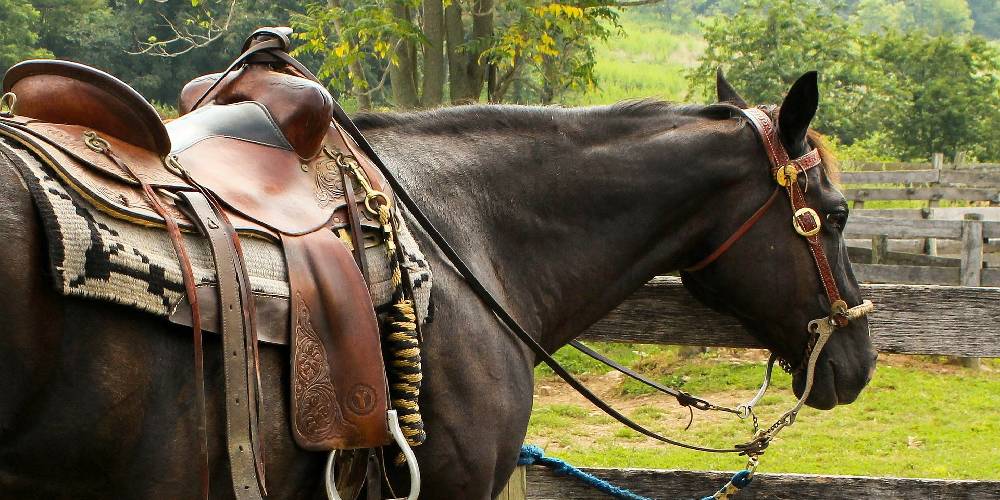Hackamores are used on horses, especially young horses in training, all across the world. These pieces of tack are used in place of a bit to guide, control, and stop horses while riding. Oftentimes, horses will be ridden in hackamores before any bit or another bridle is used on them so they can get used to what pressure means and how to respond to it. Sometimes, horses that work better without a bit or don’t require a bit to respond will use hackamores as well.
What Is A Hackamore?
A hackamore is a piece of tack used in place of a bit and bridle to control, steer, guide, and stop the horse. Hackamores, like curb bits, work off of pressure. When you pull on the reins of a hackamore, it puts pressure on the horse’s face, therefore, telling them what you want them to do. The hackamore consists of several parts that, like a curb bit, put pressure on the horse’s head and with this pressure, tells them what to do. A hackamore is mainly used on horses who are newly broke and will be used as the horse’s first bridle before a bit is put in the horse’s mouth.
What Are Hackamores Used For?
Hackamores are pieces of tack used to teach young horses to work off of pressure put on their face and head before a bit is put in their mouth. The most common age for a horse where a hackamore might be used is between the ages of three and five as this is when the horses are just newly broke. Hackamores are used to teach horses to respond to pressure so when a bit is in their mouth they know how to respond to the pressure of the bit because they learned from the hackamore.
Parts Of A Hackamore

There are so many different parts of the hackamore. The parts that you should know include:
Headstall
The headstall is kind of like the part of the hackamore that looks like a bridle. The headstall includes the brow band, crown piece, and cheek pieces of a typical bridle, but is connected to a bosal instead of a bit.
Bosal/Noseband
The bosal is a teardrop-shaped loop mainly made of rawhide that goes over the horse’s muzzle and it is held in place by the headstall.
Heel Knot
The heel knot is a knot-like knob on the bottom of the bosal on the piece that goes underneath the horse’s chin. It is to this where the Fiador, Mecate reins, and Mecate lead line are connected
Fiador
The fiador is a part of the hackamore that looks the most like a throat latch out of all of the other parts of the hackamore. The fiador is attached to the headstall, goes underneath the throat, and fastens to the heel knot under the bosal. This helps to hold the bosal in place at a certain angle.
Mecate Reins
The mecate reins are the reins used to steer a horse wearing a hackamore. The mecate reins are also attached to the heel knot of the hackamore along with the fiador and the mecate lead line. The mecate reins are used to lower the horse’s head by being used to pull back and bump on the bosal which applies pressure and encourages the horse’s head to go down.
Mecate Lead Line
The mecate lead line is a something that, like the fiador and the mecate reins, is also attached to the heel knot of the bosal. If the horse is being ridden in western, this lead line is attached to the saddle horn until it is needed.
Are Hackamores Hard To Find? & Where Can I Find Them?
Actually yes, this piece of tack is one of the harder pieces of tack to find and identify out of all the other pieces of tack. The reason for this is that it is one of the less commonly used pieces of tack used in the horse world. Most horses are ridden using a bit and a bridle rather than a hackamore which is why they are less commonly seen.
If you are wanting to buy a hackamore, look at any tack consignment store or other store that offers a variety of tack for the best bet of finding one.
What Materials Are Hackamores Made From?
The three main materials that hackamores are made from include:
- Leather
- Metal
- Rawhide.
In mechanical hackamores, metal is used in place of a rawhide bosal.
Do Hackamores Come In Different Sizes?
Yes they do. Depending on the breed, some have a need for a larger or smaller one or a need for not only a certain type of hackamore. An example of this would be a welsh pony needing a small mechanical hackamore as compared to a large quarter horse needing a bosal.
What Is The Average Cost Of A Hackamore?
For a good quality mechanical hackamore, the cost is a little hard to determine seeing there are so many different makers and styles of this type of hackamore. However, the average cost of a mechanical hackamore is $100 (USD).
The average cost of a hackamore that features a bosal can cost you about $70 (USD) depending on the make model and quality of the product.
Can Hackamores Come In Different Colors?

Yes! Hackamores can come in a variety of different colors with the most common being neutral tones like grey, brown, and white. Because nearly any headstall can be paired with a hackamore, this means that the bright colorful nylon bridles and headstalls can be paired with the functional hackamore parts to create a fun colored hackamore.
Can I Use A Hackamore Instead Of A Bit & Bridle?
Yes you absolutely can, just make sure that your horse responds to the unique pressure that the hackamore offers as compared to a bit and that they are happy using that. Some horses work better off of bit pressure so making sure that you are using what is best for your horse and what your horse is most comfortable with is most important.
Different Styles Of Hackamores
There are two styles of hackamores. One is the mechanical hackamore and the other is a hackamore that works off of a noseband known as a bosal. Both of these hackamores essentially do the same thing other than that the bosal is a little less harsh and is more old fashioned and that the mechanical hackamore is more direct and aggressive

